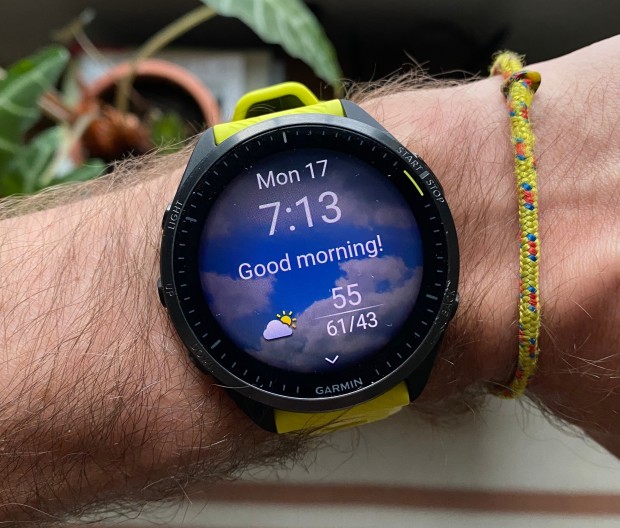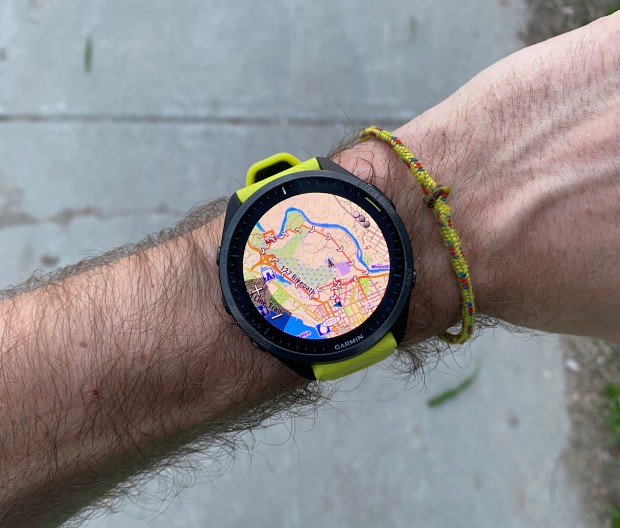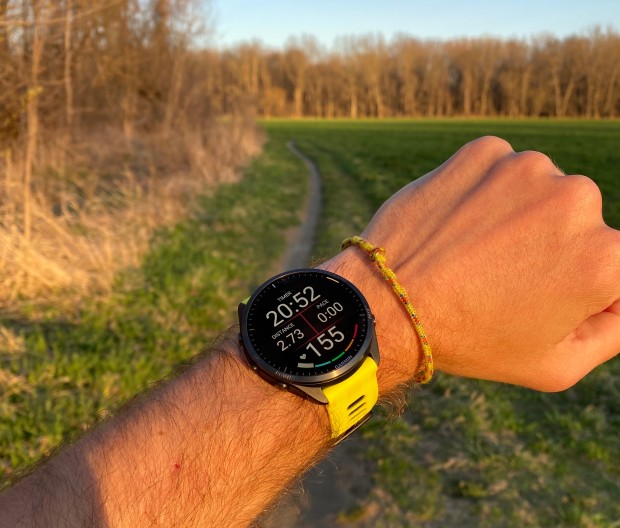For how often running is characterized as a solitary and stoic pursuit—it's just you, your shoes, and the road—it's all too easy for the sport to become entangled in modern accessories. A lot of that's due to tech; if you wanted to, you could listen to a podcast through bone-conduction Bluetooth headphones, and you could do it in a virtual group running class projected onto the screen of a multi-thousand-dollar treadmill (so much for a simple, solitary activity). I'd suggest leaving it all behind—even your earbuds—except for the one high-tech gadget I recommend to all: a Garmin watch.
When it comes to GPS watches, I'm partial to the Garmin Forerunner line of running watches; I've used the same one to train for and complete five marathons. I recently had the chance to test the new Garmin Forerunner 965 while gearing up for an upcoming marathon relay and I must say, the future of activity tracking watches is bright.
Garmin Forerunner 965 Specs at a Glance
Size: 47.2mm wide, 13.2 mm thick
Weight: 53g
Battery Life: Up to 23 days in smartwatch mode (claimed)
Touchscreen: Yes
Waterproof Rating: 5 ATM (pressure equivalent of a depth of 50 meters/164 feet)
Garmin Forerunner 965 Review: Pros & Cons
| Pros | Cons |
|---|---|
|
Bright, colorful screen and good touchscreen functionality |
Only available in a 47mm case size |
|
Very accurate GPS tracking and heart rate monitoring |
Raise-to-view doesn't always work that well |
|
AutoSelect satellite mode is accurate and efficient |
No LTE connectivity |
|
Has all of Garmin's top fitness metrics |
|
|
Allows you to listen to music without your phone |
Key Features
One of the major updates that the 965 and its smaller companion, the 265, bring to the Forerunner line is an always-on AMOLED display—in other words, a full-color, very bright watch face. The watch also has an ultralight titanium bezel (previous Garmin watches have plastic bezels) and a few new features like more detailed maps and deeper training metrics. It also comes with a USB-C charging cable, which brings that element up to the current spec for most tech devices.
The 965 currently occupies the top spot in the Forerunner collection. That means it comes packed with all the metrics for tracking not only running—outside, indoors, at the track, on trails—but also cycling, swimming, triathlons, hiking, backcountry skiing, HIIT workouts, and nearly any other active pursuit you can think of (yes, even pickleball). In addition to sport tracking, the 965 includes the important basics of GPS tracking and heart rate monitoring as well as altitude, pace, sleep, stress, VO2 max, and much more.
For battery life, Garmin says the 965 maxes out at 23 days in smartwatch mode and lasts up to 31 hours in GPS mode. Keep in mind those numbers will always be rough approximations, and the actual battery life will depend on how you use the watch and how you toggle its settings (like, for instance, the always-on display).
GPS & GNSS
One of the cooler features the watch offers is called SatIQ/AutoSelect, a setting where the watch can switch between GPS and multiband GNSS for location tracking. GNSS is more accurate in areas with tall buildings and tree cover, but it sucks up more battery life. Toggling on SatIQ/AutoSelect allows the Forerunner 965 to automatically use GNSS when it needs to and the less power-heavy traditional GPS when it doesn't, so you get accurate location tracking across a range of environments (and optimized battery life).

Tanner Bowden
Heart Rate Monitoring & Useful Reports
The Forerunner 965 uses Garmin's Elevate V4 heart rate sensor, which also records your breathing rate, heart rate variability (HRV), and blood oxygenation. But what's more interesting (and useful) than the individual output from these sensors are the algorithm-backed reports and summaries that Garmin's software uses them to create. One example is Training Readiness, which is a numerical top-line score that combines your sleep quality, recovery, training load, HRV status, and stress to give you an idea of how hard to push in your next workout.
Another helpful readout is the Morning Report, which appears on your wrist each morning when the watch senses you've woken up. It shows you info about your HRV status, Training Readiness, sleep, a suggested workout for the day, and, most importantly (in my opinion), the weather.
Then there are all the metrics that are directly attached to each activity you record—pace, heart rate, time spent in the different heart rate zones, running power, training effectiveness, split times, elevation, etc. These are must-haves in a GPS watch, but what's nice about the 965 is how its big, bright screen can display them in easy-to-read graphs; previously, I'd have to log into the Garmin Connect app on my phone or laptop to look at these metrics.

Tanner Bowden
Drawbacks
The deep activity tracking and detailed reports were highlights, but I did come across a few issues with the 965 during my testing.
A Clunky Map
It's cool to look at a full-color map of where you ran in the watch’s activity summary, but moving around that map is a clunky experience. You'd think you’d be able to use the touchscreen to drag it around like you do on your phone; instead, you have to tap small touchscreen arrow buttons that barely move the picture at all.
24/7 Wear
Another thing to watch out for is that a handful of the top-tier summaries, like Training Readiness, require you to wear the watch 24/7, so if you prefer not to sleep with a watch on or don't care about sleep data, you'll also be missing out on some of these other features.
Is the Garmin Forerunner 965 Worth It?
As I mentioned before, I've been using the same Garmin watch—the Forerunner 245 Music, which is now four years old—to get me to and through five marathons. Even though it's one of the most basic watches in the Forerunner lineup, the 245 is still a great running watch that can give you all the metrics you need to make real progress in your training.
Yet wearing the 965 was a notable step up. It reminded me of when I bought a car made in 2019 after having driven a 2001 model for two decades: I discovered that not all new features and tech updates are overcomplicated distractions (I actually like having heated seats and a rearview backup camera). Still, I don't use all of them; I bought the thing for its all-wheel drive, not the SiriusXM radio.
Before coughing up $600 for a new Garmin Forerunner 965, you or I might ask ourselves what features we actually need and value—I would definitely like better battery life and satellite functionality than what my 245 offers, and I’d also like an altimeter—and follow that up by asking if there are any other good options from other brands.
Other Options to Consider Buying
Let's say you want that AMOLED display; your other options within the Forerunner line are the 265 or 265S (the same watch but in a smaller 42mm case). The 265 came out at the same time as the 965 and is essentially a less powerful version of it. For $150 less, you sacrifice full maps, some battery life, and a few of the deeper training metrics (ones I don't think I'd miss), but you still get everything else I mentioned earlier.
If you decide that multiband GPS is a top priority, you can get it for even less in the Forerunner 255 ($350), or you can retain many of the other top-end features (including the touchscreen) but lose the AMOLED by opting for the Forerunner 955 ($500).
Outside of the Garmin line, you might check out the Coros Apex 2 Pro ($499), which has an impressive claimed battery life of 75 hours in GPS mode, advanced satellite connectivity, and a solid companion app, or, if you want a really smart smartwatch and have an iPhone, consider the Apple Watch Series 8 ($399+). It has an AMOLED display and Apple has really amped up its running metrics, though they still aren't quite as comprehensive as what you'll find in the Forerunner 965. (Check out the Men's Journal running watch guide for a full suite of options.)

Tanner Bowden
The Verdict
The Garmin Forerunner 965 is an excellent GPS watch for running and all sorts of other activities. Sitting at the top of the Garmin running watch line, it's absolutely loaded with features and functions. It offers myriad ways to analyze your workouts and physical health both during and after you're active, and it does all that on a big, beautiful screen.
But since many of those features are already available on other Garmin devices, that AMOLED screen is the key factor here. If you really want that tech but don't need Garmin's full array of top fitness watch features, you’d likely be just as happy with something more affordable (like the Forerunner 265).
[$600; garmin.com]
Related: Specialized Globe Haul ST Cargo E-bike Review
from Men's Journal https://ift.tt/DypCo5U


0 comments